CHEVROLET CAMARO 1993 Owners Manual
Manufacturer: CHEVROLET, Model Year: 1993, Model line: CAMARO, Model: CHEVROLET CAMARO 1993Pages: 358, PDF Size: 15.6 MB
Page 201 of 358
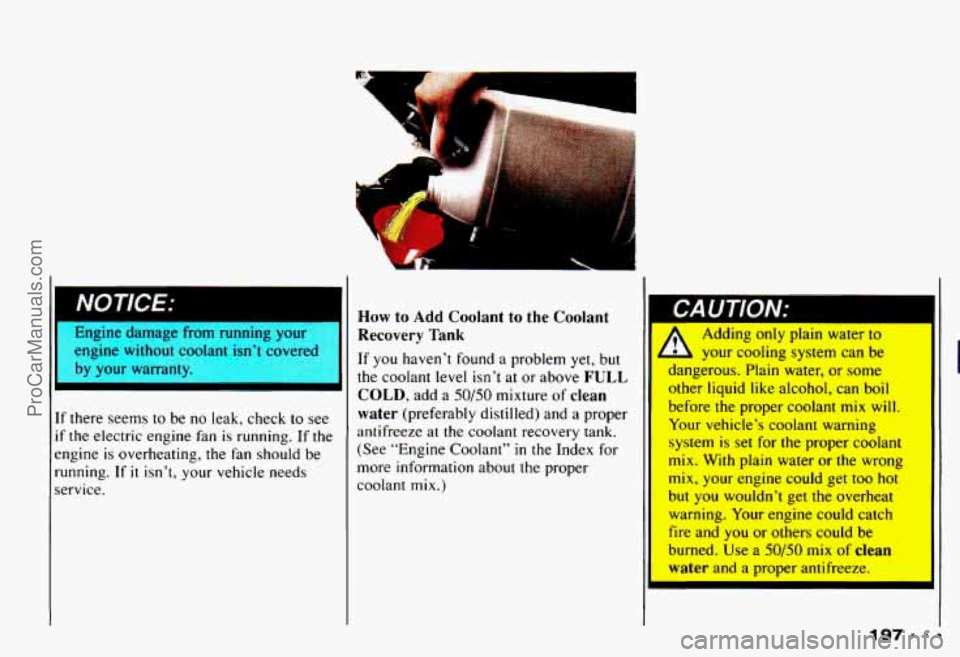
eng~ witho
r
u -.. .
tolar .-
[f there seems to be no leak, check to see
f the electric engine fan is running. If the
:ngine is overheating, the fan should be
-unning.
If it isn’t, your vehicle needs
iervice.
I I
How to Add Coolant to the Coolant
Recovery Tank
If you haven’t found a problem yet, but
the coolant level isn’t
at or above FULL
COLD,
add a 50/50 mixture of clean
water
(preferably distilled) and a proper
antifreeze at the coolant recovery tank.
(See “Engine Coolant”
in the Index for
more information about the proper
coolant
mix.)
A Adding only plain water to
L your cooling system can be
dangerous. Plain water, or some
I
other liquid like alcohol, can boil
before the proper coolant
mix will.
Your vehicle’s coolant warning
system
is set for the proper coolant
mix. With plain water or the wrong
mix, your engine could get too hot
but you wouldn’t get the overheat
warning. Your engine could catch
fire and you or others could
be
burned. Use a 50/50 mix of clean
water
and a proper antifreeze.
197-
ProCarManuals.com
Page 202 of 358
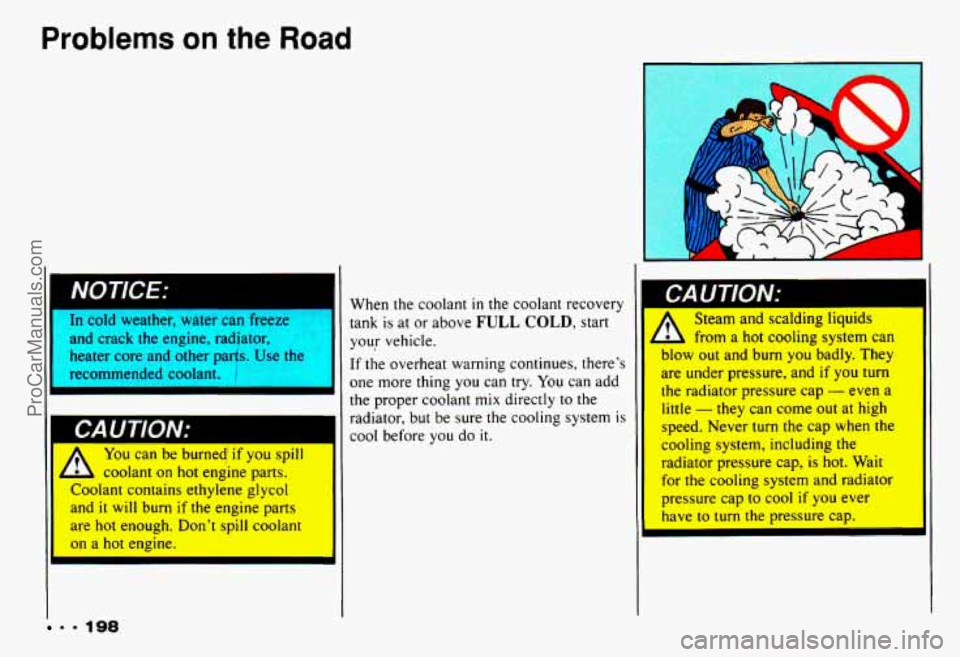
Problems on the Road
and crack the engine, radiator,
heater core and other parts.
Use the
recommended coolant.
‘I
A You can be burne4 if you spill
- L coolant on hot engine parts.
Coolant contains ethylene glycol
and
it will burn if the engine parts
are hot enough. Don’t spill coolant
on
a hot engine.
9.198
When the coolant in the coolant recovery
tank is at or above
FULL COLD, start
your vehicle.
If the overheat warning continues, there’s
one more thing you can
try. You can add
the proper coolant
mix directly to the
radiator, but be sure the cooling system is
cool before you do
it.
I
CAUTION:
Steam and scalding liquids
from a hot cooling system can
blow out and burn you badly. They
are under pressure, and
if you turn
the radiator pressure cap
- even a
little
- they can come out at high
speed. Never
turn the cap when the
cooling system, including the
radiator pressure cap,
is hot. Wait
for the cooling system and radiator
pressure cap to cool
if you ever
have to turn the pressure cap.
ProCarManuals.com
Page 203 of 358
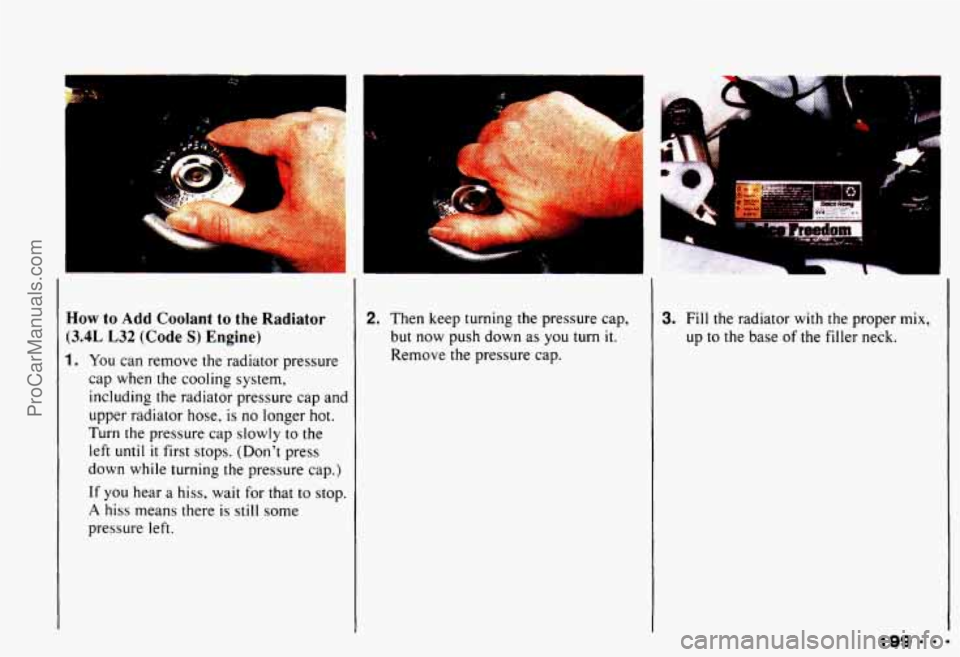
How to Add Coolant to the Radiator
(3.4L L32 (Code S) Engine)
1. You can remove the radiator pressure
cap when the cooling system,
including the radiator pressure cap and
upper radiator hose, is
no longer hot.
Turn the pressure cap slowly
to the
left
until it first stops. (Don't press
down while turning the pressure cap.)
If you hear a hiss, wait for that to stop.
A hiss means there is still some
pressure left.
2. Then keep turning the pressure cap,
but now push down
as you turn it.
Remove the pressure cap.
P
3. Fill the radiator with the proper mix,
up to the base
of the filler neck.
ProCarManuals.com
Page 204 of 358
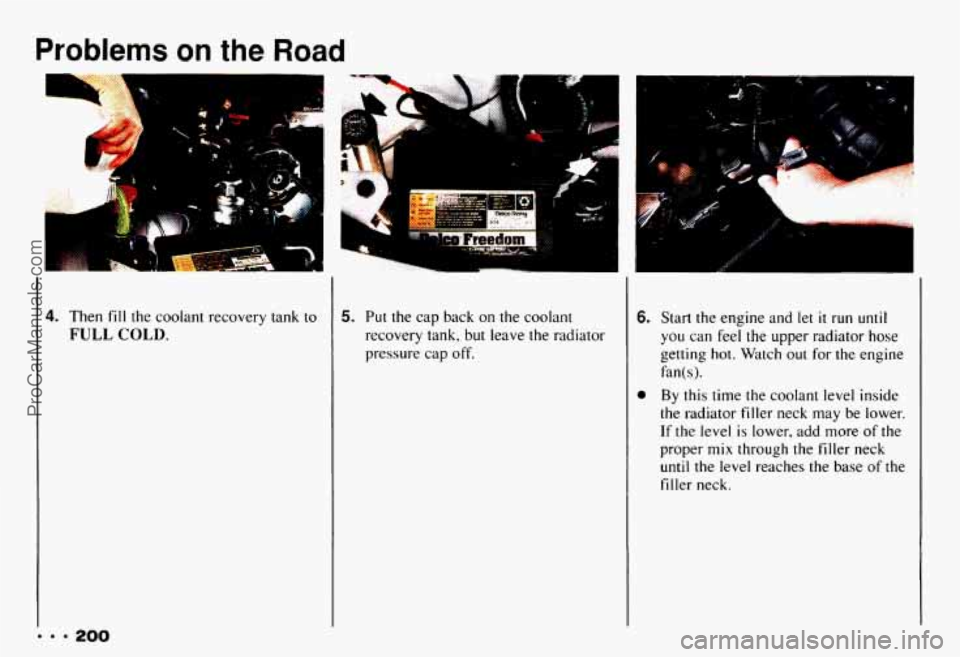
Problems on the Road
4. Then fill the coolant recovery tank to
FULL COLD.
... 200
.A 1
5. Put the cap back on the coolant
recovery tank, but leave the radiator
pressure cap off.
i
6.
0
Start the engine and let it run until
you can feel the upper radiator hose
getting hot. Watch out for the engine
fan( s).
By this time the coolant level inside
the radiator filler neck
may be lower.
If the level is lower, add more of the
proper
mix through the filler neck
until the level reaches the base of the
filler neck.
ProCarManuals.com
Page 205 of 358

m
7. Then replace the pressure cap. Be sure
the arrows on the pressure cap line up
like this. Hom7 to Add Coolant to the Radiator
(5.7L LTl (Code P) Engine)
.
II
'he 1 engine (Code P) ha
;pecmc radiator fill procedure.
%lure to follow this procedure
1. You can remove the radiator pressure
cap when the
cooling system,
including the radiator pressure cap and
upper radiator hose,
is no longer hot.
Turn the pressure cap
slowly to the
left
until it first stops. (Don't press
down while turning the pressure cap.)
If you hear a hiss, wait for that to stop.
A hiss means there is still some
pressure left.
201 -
ProCarManuals.com
Page 206 of 358
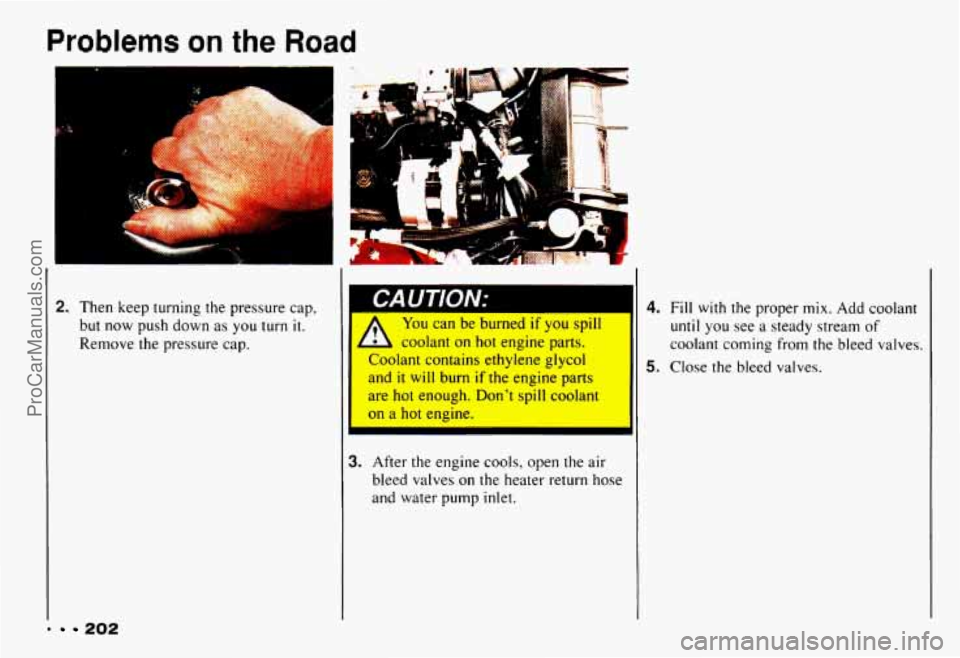
Problems on the Road
-4
I I
2. Then keep turning the pressure cap,
but now push down as you turn it.
Remove the pressure cap.
"sl
You can be burned if you spill
L coolant on hot engine parts.
4. Fill with the proper mix. Add coolant
until you see a steady stream of
coolant coming. from the bleed valves.
,oolant contains ethylene glycol
are
hot enough. Don't spill coolant
on a hot engine.
I
1 and it will burn if the engine parts 11 5. Close the bleed valves.
I
3. After the engine cools, open the air
bleed valves on the heater return hose
and water pump inlet.
. 202
ProCarManuals.com
Page 207 of 358
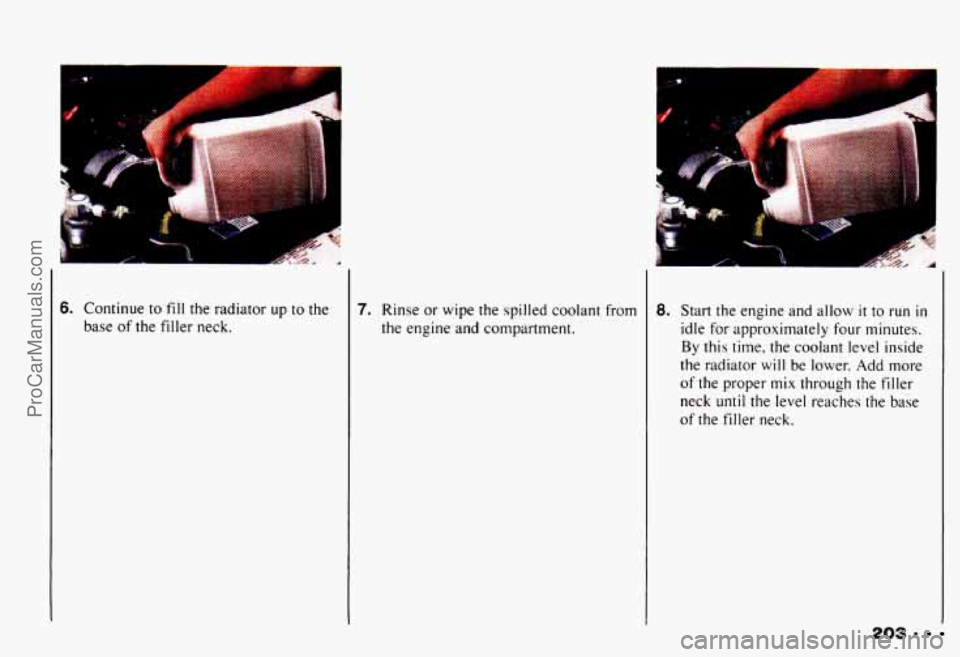
6. Continue to fill the radiator up to the
base
of the filler neck.
7. Rinse or wipe the spilled coolant from
the engine and compartment.
A I
8. Start the engine and allow it to run in
idle for approximately four minutes.
By this time, the coolant level inside
the radiator
will be lower. Add more
of the proper mix through the filler
neck
until the level reaches the base
of the filler neck.
203 9
ProCarManuals.com
Page 208 of 358
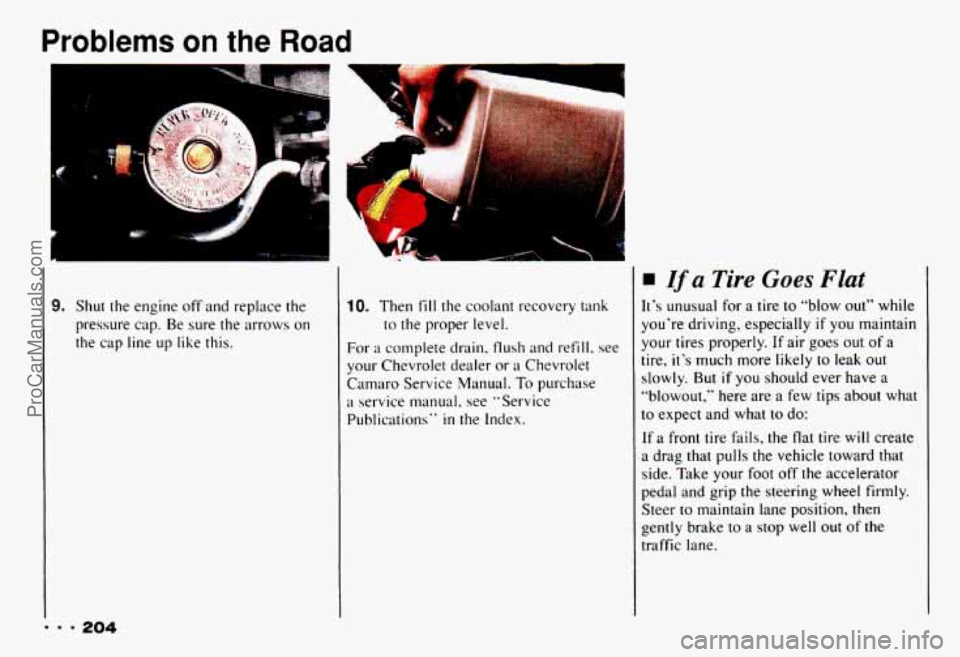
Problems on the Road
I lh
1
F. $. '
9. Shut the engine off and replace the
pressure cap. Be sure the arrows
on
the cap line up like this.
Y CI.
10. Then fill the coolant recovery tank
For a complete drain. flush and refill, see
your Chevrolet dealer or a Chevrolet
Carnaro Service
Manual. To purchase
a service manual, see "Service
Publications"
in the Index.
to the proper level.
If a Tire Goes Flat
It's unusual for
a tire to "blow out" while
you're driving, especially
if you maintain
your tires properly.
If air goes out of a
tire, it's much more likely
to leak out
slowly.
But if you should ever have a
"blowout," here are a few tips about what
to expect and what to do:
If a front tire fails, the flat tire will create
a drag that pulls the vehicle toward that
side. Take your foot off the accelerator
pedal and grip the steering wheel firmly.
Steer
to maintain lane position, then
gently brake to a stop well out of
the
traffic lane.
ProCarManuals.com
Page 209 of 358
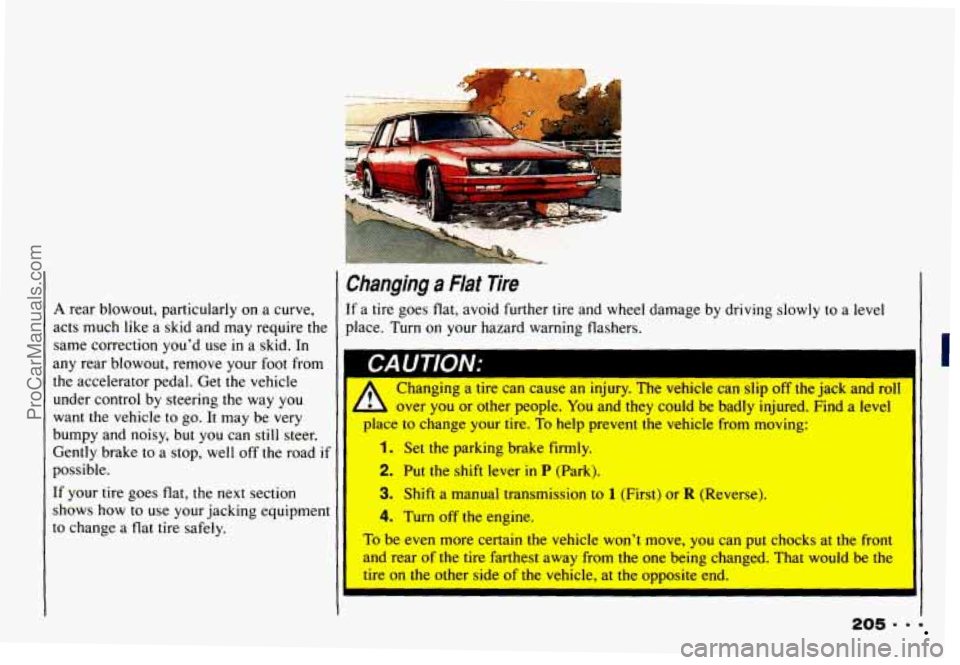
I Changing a Flat lire
’ A rear blowout, particularly on a curve, If a tire goes flat, avoid further tire and wheel damage by driving slowly to a level
acts much like a skid and may require the place. Turn on your hazard warning flashers.
If your tire goes flat, the next section
shows how to use your jacking equipment
to change a flat tire safely.
1 CAUTION:
same correction you’d use in-a skid. In I -
any rear blowout, remove your foot from
the accelerator pedal. Get the vehicle
under control by steering
the way you
want
the vehicle to go. It may be very
bumpy and noisy, but you can still steer.
Gently brake to a stop, well off the road
if
possible. (I
A Changing a tire can cause an injury. The vehicle can slip off the jack and roll
over you or other people. You and
they could be badly injured. Find a level
I place to ccange your tire. To help prevent the vehicle from moving:
1. Set the parking brake firmly.
2. Put the shift lever in P (Park).
3. Shift a manual transmission to 1 (First) or R (Reverse). I
4. Turn off the engine.
To be even more certain the vehicle won’t move, you can put chocks at the front
and rear of the tire farthest away from the one being changed. That would be
tht
tire on the other side of the vehicle, at the opposite end.
L
I
205 - =
I
ProCarManuals.com
Page 210 of 358
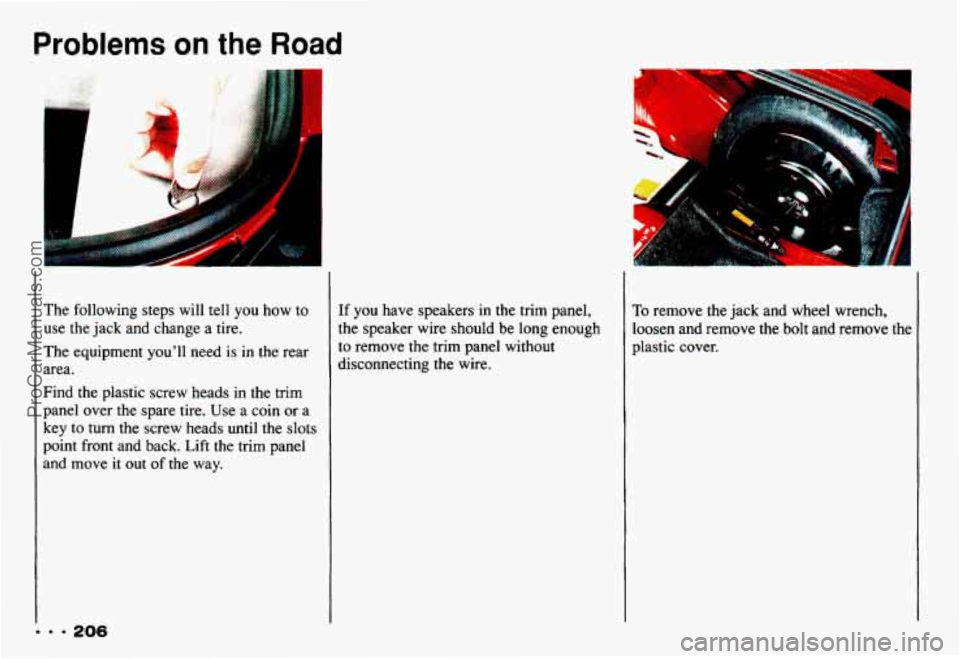
Problems on the Road
The following steps will tell you how to
use the jack and change a tire.
The equipment you'll need
is in the rear
area.
... 206
Find the plastic screw heads in the trim
panel over the spare tire. Use a coin or a
key to turn the screw heads until the slots
point front and back. Lift the trim panel
and move it
out of the way,
If you have speakers in the trim panel,
the speaker wire should be long enough
to remove
the trim panel without
disconnecting the wire.
To remove the jack and wheel wrench,
loosen and remove the bolt
and remove the
plastic cover.
ProCarManuals.com